High Q GaN/SiC-Based SAW Resonators for Humidity Sensor Applications
Abstract
:1. Introduction
2. SAW Humidity Sensor—Theoretical Background
3. Experimental Details
- -
- first, the CPW (Coplanar Wave Guide) line necessary for connecting the active area, formed by the IDT area, is defined; the metallization used in this case was Ti/Au, with a total thickness of ~100 nm (10 nm Ti/90 nm Au);
- -
- the next step consisted of the fabrication of the IDT area; for this, an EBL process was used, with the dimensions of the digits and the distance between them being 170 nm (λ = 680 nm); for the manufacture of IDTs, the metallization was TiAu, with a thickness of ~50 nm (5/45 Ti/Au);
- -
- next, an overlayer with a thickness of ~250 nm (20 nm Ti/230 nm Au) is deposited over the CPW line, which had the role to ensure the connection between the IDTs and the CPW line, but also to reduce losses;
- -
- the last step defined the functionalization layer above the IDTs; the deposition of the SiO2 layer is performed by RF sputtering and had a thickness of ~50 nm.
4. SAW Sensor Characterization
4.1. Room Temperature S Parameter Measurements of the Manufactured SAW Structures
4.2. Characterization of the Humidity SAW Sensors
5. Conclusions
Author Contributions
Funding
Data Availability Statement
Acknowledgments
Conflicts of Interest
References
- Tsujioka, T.; Iyota, H.; Ohmori, M.; Yamagata, J.; Tanaka, M.; Kitamura, H. A Water Retention Control System for Humidity Sensing at High Temperature. IEICE Tech. Rep. 2013, 113, 35–41. [Google Scholar]
- Kim, J.S.; Reucroft, P.J. Solid state water vapor sensor for robotics applications. In Proceedings of the 1988 IEEE International Conference on Robotics and Automation, Philadelphia, PA, USA, 24–29 April 1988. [Google Scholar]
- Vancauwenberghe, O.; Short, J.; Giehler, E.; Bildstein, P.; Ancey, P.; Gschwind, M. Design of the interface electronics for an integrated microsensor for the preventive detection of water condensation. In Proceedings of the International Solid-State Sensors and Actuators Conference-TRANSDUCERS’95, Stockholm, Sweden, 25–29 June 1995; Volume 1. [Google Scholar]
- Lee, C.-Y.; Lee, G.-B. Humidity sensors: A review. Sens. Lett. 2005, 3, 1–15. [Google Scholar] [CrossRef]
- Sikarwar, S.; Yadav, B.C. Opto-electronic humidity sensor: A review. Sens. Actuators 2015, 233, 54–70. [Google Scholar] [CrossRef]
- Stevens, D.S.; Andle, J.C.; Sabah, S.; Jumani, S.J.; Wall, B.W.A.; Baier, M.; Martens, T.; Gruenwald, R. Applications of Wireless Temperature Measurement Using SAW Resonators. In Fourth International Symposium on Acoustic Wave Devices for Future Mobile Communication Systems; Chiba University: Chiba, Japan, 2010. [Google Scholar]
- Fachberger, R.; Bruckner, G.; Hauser, R.; Reindl, L. Wireless SAW based high-temperature measurement systems. In Proceedings of the 2006 IEEE International Frequency Control Symposium and Exposition, Miami, FL, USA, 4–7 June 2006; pp. 358–367. [Google Scholar]
- Hollinger, R.D.; Tellakula, A.R.; Li, C.-T.; Varadan, V.V.; Varadan, V.K. Wireless surface-acoustic-wave-based humidity sensor. Proc. SPIE 1999, 3876, 54–62. [Google Scholar] [CrossRef]
- Lieberzeit, P.A.; Palfinger, C.; Dickert, F.L.; Fischerauer, G. SAW RFID-tags for mass-sensitive detection of humidity and vapors. Sensors 2009, 9, 9805–9815. [Google Scholar] [CrossRef] [PubMed]
- Greve, D.W.; Chin, T.L.; Zheng, P.; Ohodnicki, P.; Baltrus, J.; Oppenheim, I.J. Surface acoustic wave devices for harsh environment wireless sensing. Sensors 2013, 13, 6910–6935. [Google Scholar] [CrossRef]
- Pohl, A. A review of wireless SAW sensors. IEEE Trans. Ultrason. Ferroelectr. Freq. Control 2000, 47, 317–332. [Google Scholar] [CrossRef] [PubMed]
- Gao, X.; Xue, X.; Hu, F.; Zhang, C.; Cheng, L.; Liang, Y.; Wang, W. Wireless and Passive SAW-Based Humidity Sensor Employing SiO2 Thin Film. IEEE Sens. J. 2023, 23, 9936–9942. [Google Scholar] [CrossRef]
- Eryürek, M.; Tasdemir, Z.; Karadag, Y.; Anand, S.; Kilinc, N.; Alaca, B.E.; Kiraz, A. Integrated humidity sensor based on SU-8 polymer microdisk microresonator. Sens. Actuators B Chem. 2017, 242, 1115–1120. [Google Scholar] [CrossRef]
- Wang, Y.; Zhang, S.Y.; Fan, L.; Shui, X.J.; Yang, Y.T. Surface acoustic wave humidity sensors based on ZnO piezoelectric films sputtered on R-sapphire substrates. Chin. Phys. Lett. 2015, 32, 086802. [Google Scholar] [CrossRef]
- Nicoloiu, A.; Boldeiu, G.; Nastase, C.; Nedelcu, M.; Ciornei, C.; Zdru, I.; Stavrinidis, G.; Vasilache, D.; Stavrinidis, A.; Dinescu, A.; et al. Temperature Behaviour of Rayleigh, Sezawa and Lamb mode resonance frequencies of 30% ScAlN/Si SAW Devices. In Proceedings of the 22nd International Conference on Solid-State Sensors, Actuators and Microsystems (Transducers), Kyoto, Japan, 25–29 June 2023. [Google Scholar]
- Vasilache, D.; Nicoloiu, A.; Boldeiu, G.; Zdru, I.; Kostopoulos, T.; Nedelcu, M.; Stavrinidis, A.; Nastase, C.; Stavrinidis, G.; Konstantinidis, G.; et al. Development of high frequency SAW devices devoted for pressure sensing. In Proceedings of the International Semiconductor Conference (CAS), Sinaia, Romania, 12–14 October 2022; pp. 91–94. [Google Scholar]
- Memon, M.M.; Liu, Q.; Manthar, A.; Wang, T.; Zhang, W. Surface AcousticWave Humidity Sensor: A Review. Micromachines 2023, 14, 945. [Google Scholar] [CrossRef] [PubMed]
- Pan, Y.; Yan, C.; Gao, X.; Yang, J.; Guo, T.; Zhang, L.; Wang, W. A passive wireless surface acoustic wave (SAW) sensor system for detecting warfare agents based on fluoroalcohol polysiloxane film. Microsyst. Nanoeng. 2024, 10, 4. [Google Scholar] [CrossRef] [PubMed]
- Aslam, M.Z.; Zhang, H.; Good, M.; Guo, Y.; Larche, M. A multimodal lithium niobate-based SAW gas sensor for accurate detection of carbon dioxide at elevated temperature. Ultrasonics 2024, 138, 107198. [Google Scholar] [CrossRef] [PubMed]
- Pedros, J.; Calle, F.; Grajal, J.; Riobóo, R.J.; Prieto, C.; Pau, J.L.; Pereiro, J.; Hermann, M.; Eickhoff, M.; Bougrioua, Z. Anisotropic propagation of surface acoustic waves on nitride layers. Superlattices Microstruct. 2004, 36, 815–823. [Google Scholar] [CrossRef]
- Palacios, T.; Calle, F.; Grajal, J.; Monroy, E.; Eickhoff, M.; Ambacher, O.; Omnes, F. High frequency SAW devices on AlGaN: Fabrication, characterization and integration with optoelectronics. In Proceedings of the 2002 IEEE Ultrasonics Symposium, 2002. Proceedings, Munich, Germany, 8–11 October 2002; pp. 57–60. [Google Scholar]
- Müller, A.; Neculoiu, D.; Konstantinidis, G.; Deligeorgis, G.; Dinescu, A.; Stavrinidis, A.; Cismaru, A.; Dragoman, M.; Stefanescu, A. SAW Devices Manufactured on GaN/Si for Frequencies Beyond 5 GHz. IEEE Electron. Device Lett. 2010, 31, 1398–1400. [Google Scholar] [CrossRef]
- Rodriguez-Madrid, J.G.; Iriarte, G.F.; Williams, O.A.; Calle, F. High precision pressure sensors based on SAW devices in the GHz range. Sens. Actuators A Phys. 2013, 189, 364–369. [Google Scholar] [CrossRef]
- Assouar, M.B.; Elmazria, O.; Kirsch, P.; Alnot, P.; Mortet, V.; Tiusan, C. High-frequency surface acoustic wave devices based on AIN/diamond layered structure realized using e-beam lithography. J. Appl. Phys. 2007, 101, 114507. [Google Scholar] [CrossRef]
- Zdru, I.; Ciubotaru, F.; Nastase, C.; Florescu, A.; Hamadeh, A.A.; Geilen, M.; Nicoloiu, A.; Boldeiu, G.; Vasilache, D.; Iordanescu, S.; et al. Interaction of acoustic waves with spin waves using a GHz operating GaN/Si SAW device with a Ni/NiFeSi layer between its IDTs. IEEE Trans. Ultrason. Ferroelectr. Freq. Control, 2024; Early Access. [Google Scholar] [CrossRef] [PubMed]
- Boldeiu, G.; Ponchak, G.E.; Nicoloiu, A.; Nastase, C.; Zdru, I.; Dinescu, A.; Müller, A. Investigation of temperature sensing capabilities of GaN/SiC and GaN/sapphire surface acoustic wave devices. IEEE Access 2022, 10, 741–752. [Google Scholar] [CrossRef]
- Qamar, A.; Ghatge, M.; Tabrizian, R.; Rais-Zadeh, M. Thermo-acoustic engineering of GaN SAW resonators for stable clocks in extreme environments. In Proceedings of the IEEE 33rd International Conference on Micro Electro Mechanical Systems, Vancouver, BC, Canada, 18–22 January 2020; pp. 1211–1214. [Google Scholar]
- Muller, A.; Konstantinidis, G.; Giangu, I.; Adam, G.C.; Stefanescu, A.; Stavrinidis, A.; Stavrinidis, G.; Kostopoulos, A.; Boldeiu, G.; Dinescu, A. GaN Membrane Supported SAW Pressure Sensors With Embedded Temperature Sensing Capability. IEEE Sens. J. 2017, 17, 7383–7393. [Google Scholar] [CrossRef]
- Caliendo, C.; Verona, E.; Anisimkin, V.I. Surface acoustic wave humidity sensors: A comparison between different types of sensitive membrane. Smart Mater. Struct. 1997, 6, 707–715. [Google Scholar] [CrossRef]
- Ballantine, D.S., Jr.; White, R.M.; Martin, S.J.; Ricco, A.J.; Zellers, E.T.; Frye, G.C.; Wohltjen, H. Acoustic Wave Sensors: Theory, Design, & Physico-Chemical Applications; Academic Press: Cambridge, MA, USA, 1997. [Google Scholar]
- Pasternak, M. Overtone oscillator for SAW gas detectors. IEEE Sens. J. 2006, 6, 1497–1501. [Google Scholar] [CrossRef]
- Le, X.; Liu, Y.; Peng, L.; Pang, J.; Xu, Z.; Gao, C.; Xie, J. Surface acoustic wave humidity sensors based on uniform and thickness controllable graphene oxide thin films formed by surface tension. Microsyst. Nanoeng. 2019, 5, 36. [Google Scholar] [CrossRef] [PubMed]
- Alam, S. A Sensitive Inexpensive SAW Sensor for Wide Range Humidity Measurement. IEEE Sens. J. 2020, 20, 546–551. [Google Scholar] [CrossRef]
- Dou, Y.; Li, C.; Luo, W.; Qian, L.; Wang, L.; Li, D.; Li, H.; Li, M. Surface acoustic wave relative humidity sensor based on GO/TiO2 sensitive film. Sens. Actuators A Phys. 2024, 365, 114906. [Google Scholar] [CrossRef]
- Tang, Y.; Li, Z.; Ma, J.; Wang, L.; Yang, J.; Du, B.; Yu, Q.; Zu, X. Highly sensitive surface acoustic wave (SAW) humidity sensors based on sol–gel SiO2 films: Investigations on the sensing property and mechanism. Sens. Actuators B 2015, 215, 283–291. [Google Scholar] [CrossRef]
- Cartailler, V.; Imbert, G.; Rochat, N.; Chaton, C.; Vo-Thanh, D.; Benoit, D.; Duchamp, G.; Frémont, H. Moisture diffusion in plasma-enhanced chemical vapor deposition dielectrics characterized with three techniques under clean room conditions. Thin Solid Films 2020, 698, 137874. [Google Scholar] [CrossRef]
- Alam, S.; Mittal, U.; Islam, T. The oxide film-coated surface acoustic wave resonators for the measurement of relative humidity. IEEE Trans. Instrum. Meas. 2021, 70, 9508409. [Google Scholar] [CrossRef]
- Mahmoud, A.; Mukherjee, T.; Piazza, G. A Study of Quality Factor in SAW Resonators for SAW Gyroscope Applications. In Proceedings of the 2020 Joint Conference of the IEEE International Frequency Control Symposium and International Symposium on Applications of Ferroelectrics (IFCS-ISAF), Keystone, CO, USA, 19–23 July 2020; pp. 1–3. [Google Scholar] [CrossRef]
- Park, M.; Hao, Z.; Dargis, R.; Clark, A.; Ansari, A. Epitaxial Aluminum Scandium Nitride Super High Frequency Acoustic Resonators. J. Microelectromech. Syst. 2020, 29, 490–498. [Google Scholar] [CrossRef]
- Ralib, A.A.M.; Razali, N.F.M.; Chatras, M.; Nordin, A.N.; Rahman, F.D.A.; Pothier, A.; Passerieux, D.; Guines, C. Enhancement of Quality Factor in ST-cut Quartz Surface Acoustic Wave Devices by using Different Numbers of IDTs and Wavelengths for gas sensing. In Proceedings of the 2023 IEEE International Instrumentation and Measurement Technology Conference (I2MTC), Kuala Lumpur, Malaysia, 22–25 May 2023; pp. 1–4. [Google Scholar] [CrossRef]
- Zhao, Y.-G.; Liu, M.; Li, D.-M.; Li, J.-J.; Niu, J.-B. FEM modeling of SAW organic vapor sensors. Sens. Actuators A Phys. 2009, 154, 30–34. [Google Scholar] [CrossRef]
- Wang, W.; Lee, K.; Kim, T.; Park, I.; Yang, S. A novel wireless, passive CO2 sensor incorporating a surface acoustic wave reflective delay line. Smart Mater. Struct. 2007, 16, 1382. [Google Scholar] [CrossRef]
- COMSOL MultiPhysics. Reference Manual. Available online: https://doc.comsol.com/6.2/doc/com.comsol.help.comsol/COMSOL_ReferenceManual.pdf (accessed on 8 January 2025).
- Müller, A.; Konstantinidis, G.; Buiculescu, V.; Dinescu, A.; Stavrinidis, A.; Stefanescu, A.; Stavrinidis, G.; Giangu, I.; Cismaru, A.; Modoveanu, A. GaN/Si based single SAW resonator temperature sensor operating in the GHz frequency range. Sens. Actuators A: Phys. 2014, 209, 115–123. [Google Scholar] [CrossRef]
- Müller, A.; Konstantinidis, G.; Giangu, I.; Buiculescu, V.; Dinescu, A.; Stefanescu, A.; Stavrinidis, A.; Stavrinidis, G.; Ziaei, A. GaN-based SAW structures resonating within the 5.4–8.5 GHz frequency range, for high sensitivity temperature sensors. In Proceedings of the 2014 IEEE MTT-S International Microwave Symposium (IMS2014), Tampa, FL, USA, 1–6 June 2014; pp. 1–4. [Google Scholar]
- Liao, C.-H.; Huang, T.-C.; Yen, Z.-H.; Huang, C.-S.; Water, W.; Lin, S.-H. ZnO Nanorods Morphology Control in Hydrothermal Method and their Humidity Sensing Enhancement on AlN SAW Device. In Proceedings of the 2023 IEEE 23rd International Conference on Nanotechnology (NANO), Jeju Island, Republic of Korea, 2–5 July 2023. [Google Scholar]
- Memon, M.M.; Hongyuan, Y.; Pan, S.; Wang, T.; Zhang, W. Surface acoustic wave humidity sensor based on hydrophobic polymer film. J. Electron. Mater. 2022, 51, 5627–5634. [Google Scholar] [CrossRef]
- Yan, X.; Li, C.; Zhao, L.; Tian, S.; Zhang, Z.; Li, M.; Li, H.; Qian, L.; Gong, X.; Huang, Y.; et al. Surface acoustic wave relative humidity sensor based on sputtering SiO2 film. Surf. Interface Anal. 2021, 53, 867–875. [Google Scholar] [CrossRef]
- Xu, Z.; Li, Z. Dynamic humidity response of surface acoustic wave sensors based on zinc oxide nanoparticles sensitive film. Appl. Phys. A 2021, 127, 422. [Google Scholar] [CrossRef]
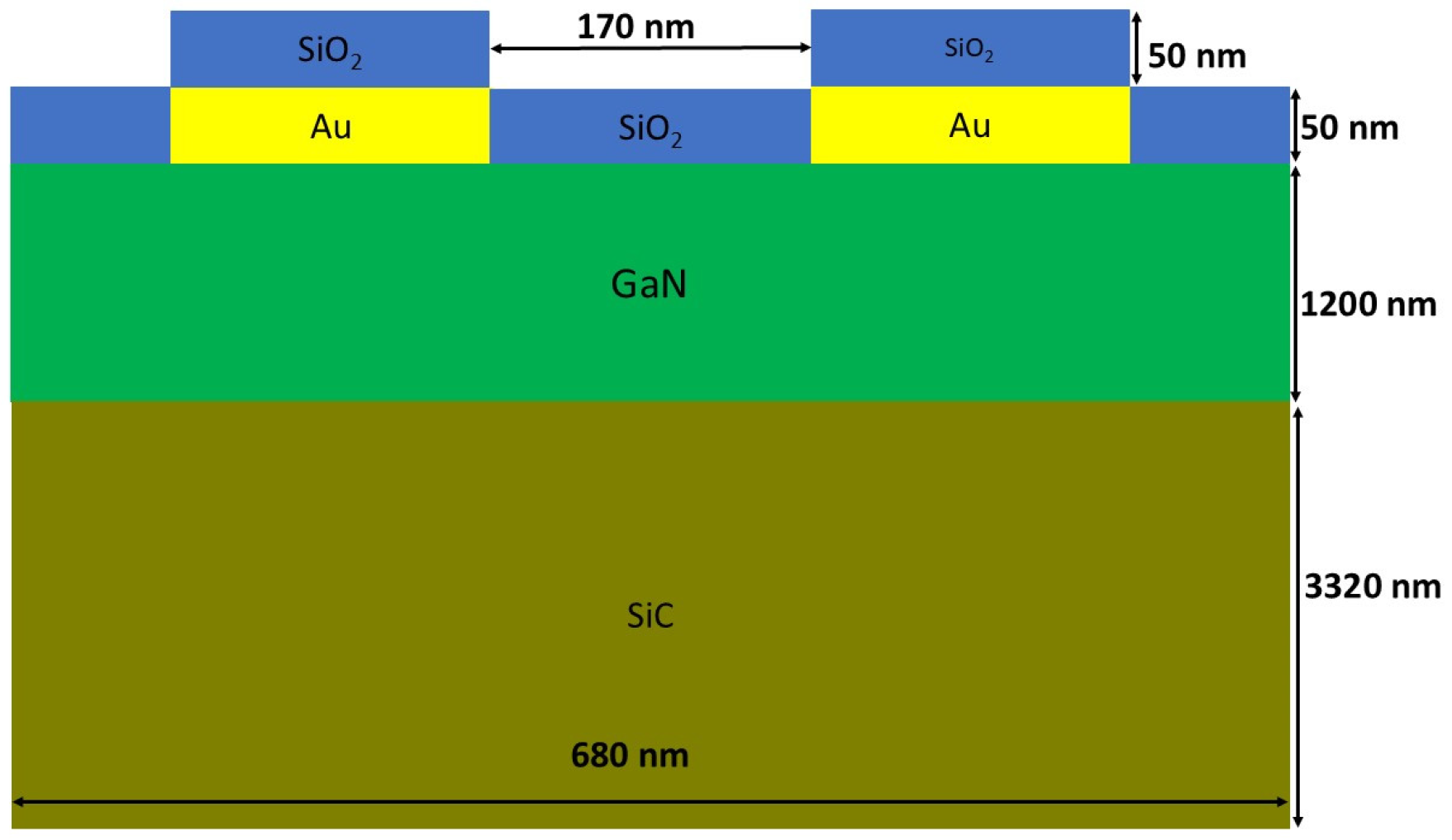
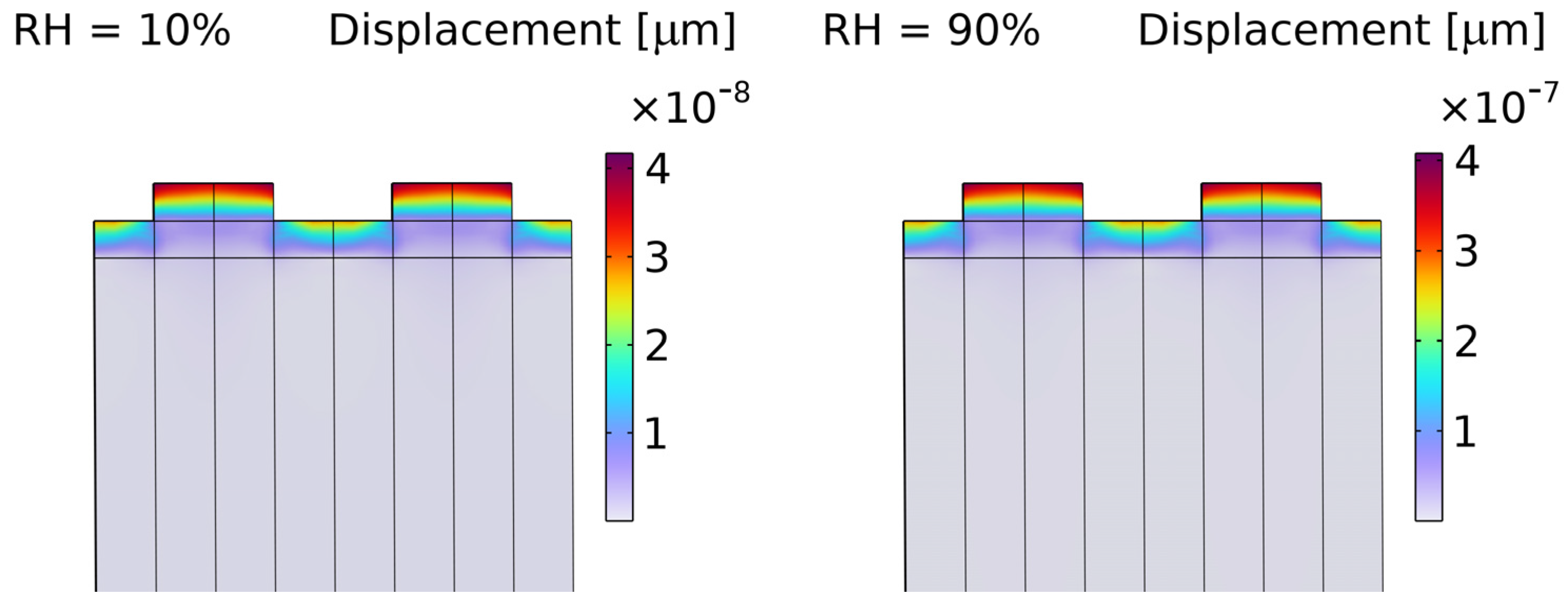
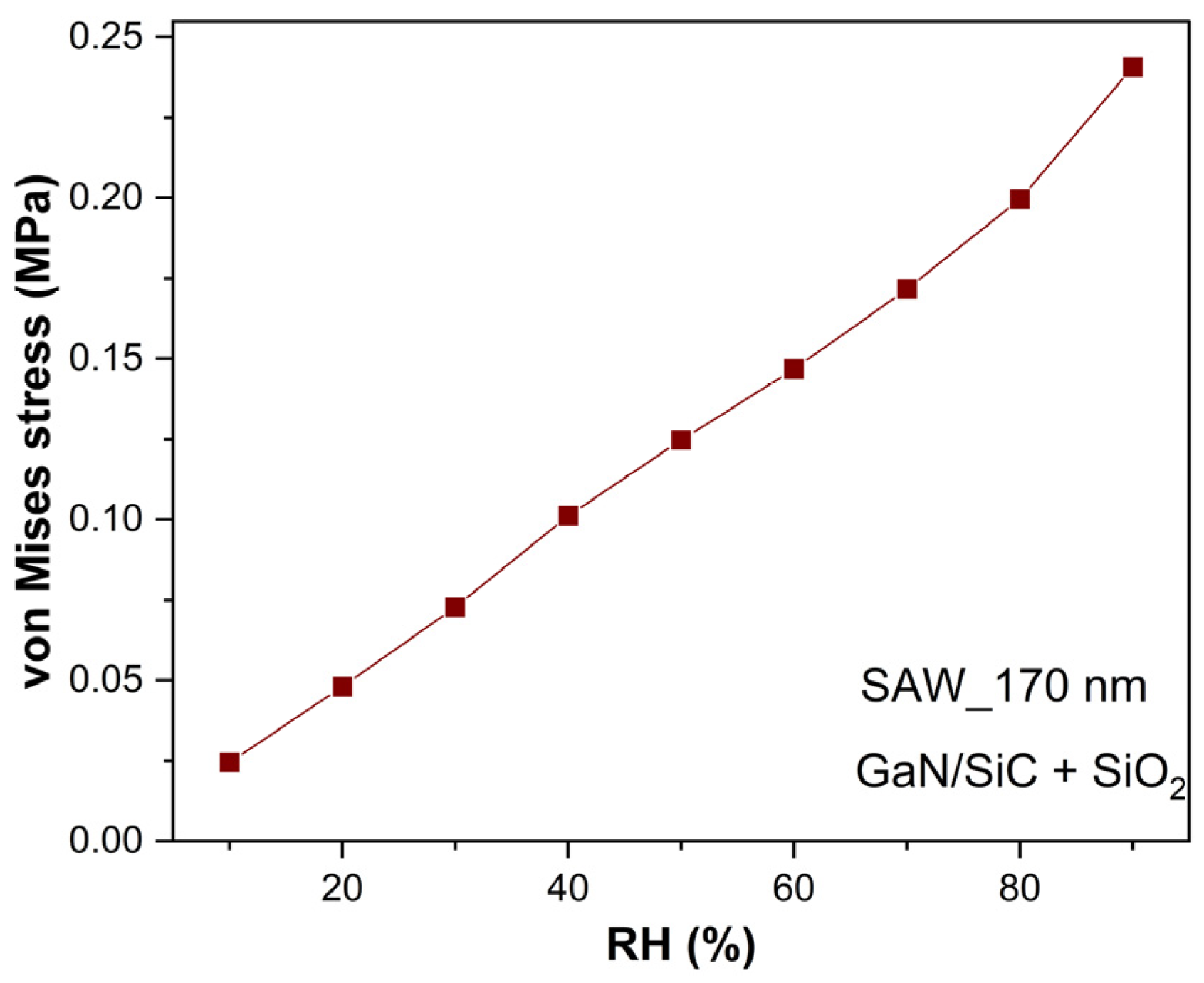

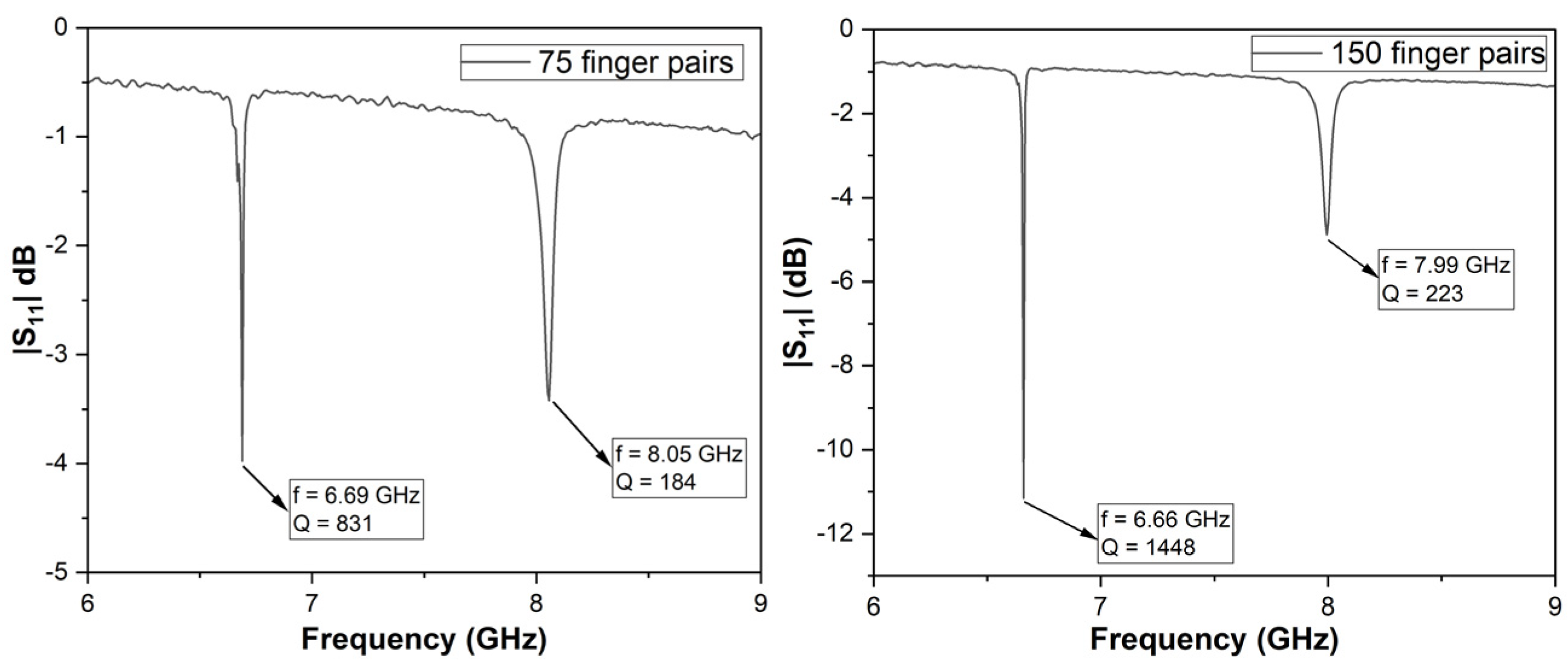
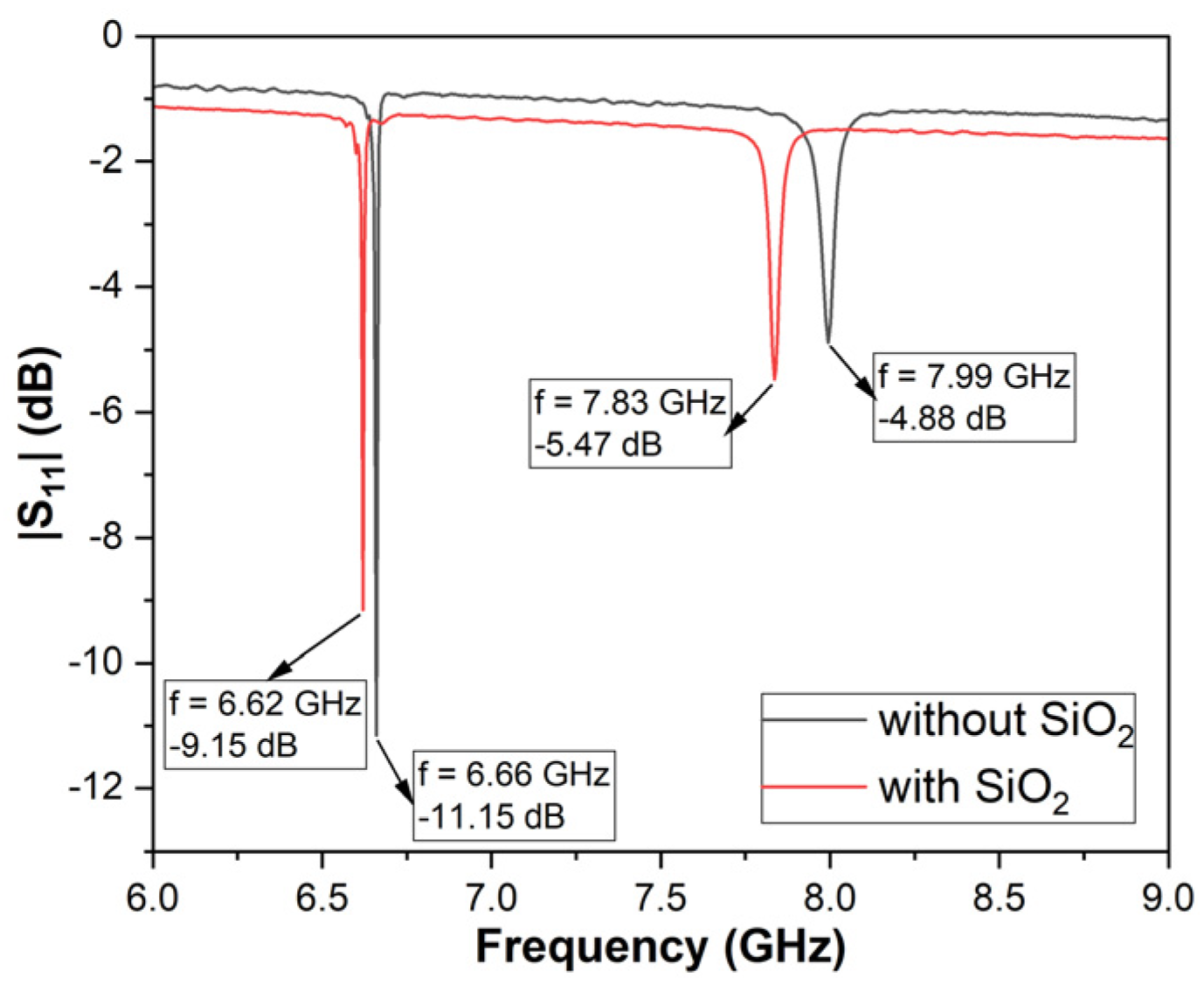

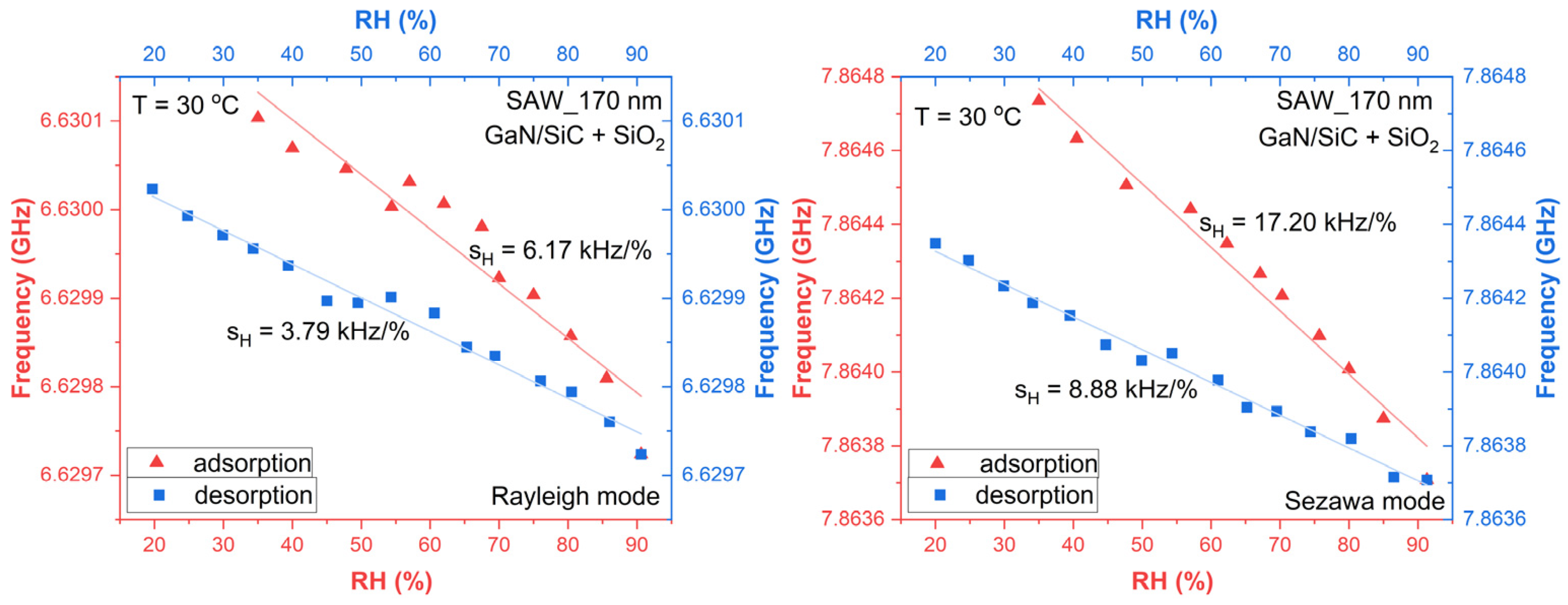
| Parameter (Unit) | Symbol | Rayleigh | Sezawa |
|---|---|---|---|
| Quality factor | Q | 1697 | 290 |
| Coupling coefficient (%) | 0.37 | 1.1 | |
| Fractional bandwidth (%) | FBW | 0.15 | 0.44 |
| Sensing Material | Substrate | RH (%) Range | Sensitivity (kHz/%RH) * | References |
|---|---|---|---|---|
| Sputtering SiO2 film | GaN/SiC | 35 … 90 | 6.17 (Rayleigh) 17.20 (Sezawa) | present work |
| GO/TiO2 | Quartz | 10 … 90 | 13.945 | [34] |
| Sol–gel SiO2 film | Quartz | 30 … 93 | 7.46 | [35] |
| ZnO nanorods | AlN | 30 … 90 | 3.77 | [46] |
| Fluorinated polyimide PI | AlN | 10 … 90 | 4.15 | [47] |
| Sputtering SiO2 film | Quartz | 10 … 80 | 1.14 | [48] |
| ZnO nanoparticles | Quartz | 20 … 95 | 0.237 (Rayleigh) 0.388 (Sezawa) | [49] |
Disclaimer/Publisher’s Note: The statements, opinions and data contained in all publications are solely those of the individual author(s) and contributor(s) and not of MDPI and/or the editor(s). MDPI and/or the editor(s) disclaim responsibility for any injury to people or property resulting from any ideas, methods, instructions or products referred to in the content. |
© 2025 by the authors. Licensee MDPI, Basel, Switzerland. This article is an open access article distributed under the terms and conditions of the Creative Commons Attribution (CC BY) license (https://creativecommons.org/licenses/by/4.0/).
Share and Cite
Vasilache, D.; Nastase, C.; Boldeiu, G.; Nedelcu, M.; Parvulescu, C.; Dinescu, A.; Muller, A. High Q GaN/SiC-Based SAW Resonators for Humidity Sensor Applications. Micromachines 2025, 16, 150. https://doi.org/10.3390/mi16020150
Vasilache D, Nastase C, Boldeiu G, Nedelcu M, Parvulescu C, Dinescu A, Muller A. High Q GaN/SiC-Based SAW Resonators for Humidity Sensor Applications. Micromachines. 2025; 16(2):150. https://doi.org/10.3390/mi16020150
Chicago/Turabian StyleVasilache, Dan, Claudia Nastase, George Boldeiu, Monica Nedelcu, Catalin Parvulescu, Adrian Dinescu, and Alexandru Muller. 2025. "High Q GaN/SiC-Based SAW Resonators for Humidity Sensor Applications" Micromachines 16, no. 2: 150. https://doi.org/10.3390/mi16020150
APA StyleVasilache, D., Nastase, C., Boldeiu, G., Nedelcu, M., Parvulescu, C., Dinescu, A., & Muller, A. (2025). High Q GaN/SiC-Based SAW Resonators for Humidity Sensor Applications. Micromachines, 16(2), 150. https://doi.org/10.3390/mi16020150









